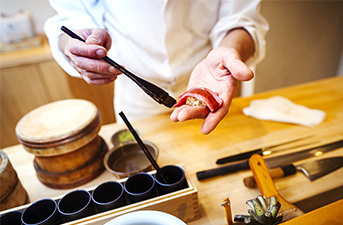Restaurants(10755)
Jeeten
The name of this restaurant comes from the Chinese pronunciation of owner-chef Katsuhiko Yoshida’s name — similar to how Japanese yakuzen cuisine and Chinese influence come together in its kitchen.
Trattoria Buca’Massimo
The highlight of this Michelin Bib Gourmand restaurant is the bistecca alla fiorentina, a traditional Tuscan steak weighing up to 800 grams, and measuring up to four centimeters thick.
Bistro Glouton
This Ikejiri-Ohashi restaurant run by a husband-wife duo offers the quintessential French bistro experience. Classic French fare like duck confit and ratatouille employs the best of Japan’s seasonal produce.
Lien
Offering courses of flavor and sentiment, the Michelin-recognized Lien offers an intimate, insightful French dining experience. All courses are made using fresh ingredients from the chef’s hometown in Aomori for a personal touch.

Matsunozushi
The Michelin-recognized craftsmanship behind Matsunozushi’s classic Edomae-style sushi, paired with a homely atmosphere, makes this tiny Shiinamachi restaurant a must-visit for avid sushi fans.

Soba Osame
Pairing rustic soba with regional small plates, Soba Osame mirrors the idyllic glades and Thoreauvian mountain towns of Japan through its menu.

Tonkatsu Narikura
The characteristic white color of the tonkatsu batter at this Minami-Asagaya restaurant comes from a low-temperature frying process that gives the pork maximum juiciness — and a Michelin Bib Gourmand award.
Tohakuan Karibe
The highlight of this Michelin Bib Gourmand soba restaurant is its extensive wine selection, which changes every week at the recommendation of a sommelier. Seasonal tempura offerings keep guests coming back for more.
La Luce (Kanazawa)
At this restaurant near the Kenrokuen Gardens, top-quality ingredients from France, Italy and the Kanazawa locality are expertly made into French-inspired Italian cuisine, served atop gorgeous artisanal Imari porcelain.
Yakiniku Kokonomi
This Ebisu yakiniku restaurant’s name literally means “only here”, referring to its claim to serve the “original” wagyu beef — Takenotani-tsuru beef from Okayama — that can only be eaten there.
Hiroshima Yagumo
This Hiroshima hotpot restaurant was serving shabu-shabu before it was even called shabu-shabu. Tuck into the finest Japanese beef dipped in a homemade sauce, all while surrounded by traditional Japanese folk art.
Tatsumi Sushi
Solid fundamentals meet a flourish of Chef Matsuhata Taminobu’s creativity at his Fukuoka sushi restaurant. Here, each nigiri is seen as its own individual course.
Yagumo Nagarekawa
At the Nagarekawa branch of one of the first restaurants to serve shabu-shabu, guests can enjoy the finest kuroge wagyu black beef in a homemade sauce, all while surrounded by traditional Japanese folk art.
Wagyu Amiyaki Kaiseki Sizzler
For over 50 years, this Hiroshima yakiniku restaurant has offered 25 different cuts of beef from every possible part of the cow. Each one is kuroge wagyu black beef from the Hiroshima region for maximum freshness.
Teppanryori Mimitei
Discover Hiroshima’s best-kept secret at this teppanyaki restaurant: Hiroshima beef, which has a melting point so low it literally melts in the mouth.
Halal Sukiyaki Restaurant Diyafa
One of the first of its kind, Chef Osagawa Hideki’s halal sukiyaki restaurant near Mita offers Muslim diners a chance to try this Japanese staple, with top-quality Shiretoko wagyu beef from Hokkaido.
Kagurazaka Kuzuryu Soba
The pride of Fukui Prefecture, Echizen cuisine features prominently in this Kagurazaka restaurant, which uses the finest ingredients from the Hokuriku region. Seasonal delicacies from the Echizen Coast and local sake delight visitors.
Fujiyoshi
Active for over 60 years, this Tenjin restaurant offers the winning combination of yakitori and sashimi, the latter made from fish kept alive in tanks right up to the moment of preparation.
Robata Omoto Kagurazaka
Charcoal-grilled Hokkaido pork, beef and seafood in the heart of Tokyo’s former geisha district Kagurazaka. Pair this intimate, rustic robatayaki experience with a glass of local Hokkaido sake or shochu.
Shunsai Hayato
Cuisine fit for a king. Near the Korakuen Gardens, this Okayama restaurant keeps the cuisine of the feudal lords of fine otonosama-ryori alive. Feast on fresh sashimi and Chiya beef, a wagyu cattle so rare it bears the title of “phantom wagyu”.
Hondori Sasa
This central Hiroshima restaurant prepares fresh Setouchi seafood and other local seasonal ingredients through a variety of ancient grilling methods that have been all but lost to time.
Sumiyaki Kaminari Main Store
This legendary Hiroshima yakitori restaurant uses a combination of “tohbi” distant-fire charcoal grilling to seal in the flavor, as well as a tashi-tsugi sauce that has been continuously added to for over 40 years of operation.
Sumiyaki Kaminari Shintenchi
This legendary Hiroshima yakitori restaurant uses a combination of “tohbi” distant-fire charcoal grilling to seal in the flavor, as well as a tashi-tsugi sauce that has been continuously added to for over 40 years of operation.
Sumiyaki Kaminari Tatemachi
This legendary Hiroshima yakitori restaurant uses a combination of “tohbi” distant-fire charcoal grilling to seal in the flavor, as well as a tashi-tsugi sauce that has been continuously added to for over 40 years of operation.
Sushi Tomo
Enjoy Chef Tomonaga Toshiharu’s signature sushi with natural salt from Nagasaki’s Goto Islands and a generous squeeze of citrus juice, made with the finest Fukuoka seafood purchased fresh every morning.
Hakata Nakasu Rokusantei
With over 60 years of history, this Nakasu riverside restaurant serves the deadly poisonous fugu in various forms from hotpot to sashimi, alongside other local Fukuoka delicacies. Expert chefs prepare it at the counter right before guests’ eyes.
Kagurazaka Tempura Tenko
Chef Arai Hitoshi’s family has been making tempura at his Kagurazaka restaurant for almost 50 years, and he has lectured on the subject from Paris to New York. His secret ingredient? A focus on hospitality.
Minokichi Shinsaibashi Midosuji
The best of seasonal Kyoto-style cuisine rightfully enjoyed in traditional, folk-craft-filled dining rooms.

